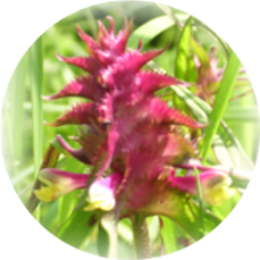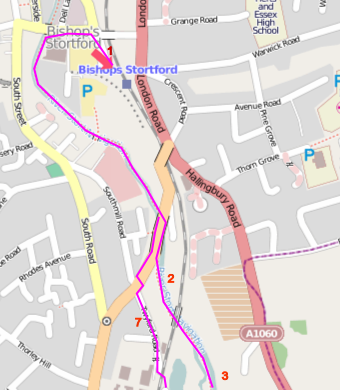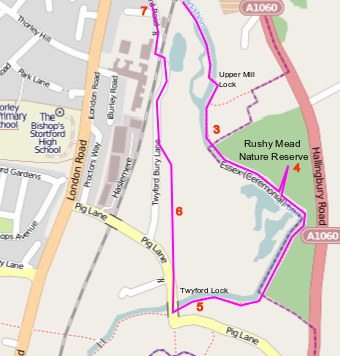Wildlife Walk 6 – Bishops Stortford and the Rushy Mead nature reserve
A walk of about four miles to see the River Stort and Essex Wildlife Trust Rushy Mead nature reserve.
OS Landranger Sheet 167. Starting from Bishops Stortford Station car park OS Reference TL492209, or other town centre areas.
© OpenStreetMap contributors, CC-BY-SA
1. Start at the station Car Park, and walk to and through the bus station to join Station Road bearing left towards the bridge. At the bridge bear left dropping down onto the River Stort tow path. Follow the tow path passing the Leisure Centre and then underneath a modern footbridge that spans the river in a dramatic way, to reach London Road.
2. Once on the pavement of London Road, carefully cross the road at the traffic lights and walk to the right to rejoin the tow path through an opening at the other end of the bridge, this time the path runs on the other side of the River Stort. Continue on the path going underneath the railway line and then onto a long footbridge that crosses a large weir. This is an attractive spot, where waterfowl are usually visible, and take time to stop and look down into the still water to see the range of aquatic life that finds a home here. Continue on a short distance to reach Upper Mill Lock, where you will cross back to the other side of the river. Grey Wagtails may sometimes be seen near the weir and lock and Kingfishers occasionally visit the river in this area.
© OpenStreetMapcontributors, CC-BY-SA
3. Continue on and eventually you will reach the beginning of the Nature Reserve on the left, but go a little further along the tow path to reach a reserve sign where it is possible to enter the reserve via a boardwalk.
4. Walking over the boardwalk proceed up the rise to an open space, which is a good meadow in summer, and at the far end you will find another detailed map of the reserve. You can use the internal paths to see around the reserve, but beware and stick to the paths, as the lower lying areas are very wet underfoot and crossed by deep ditches. This low-lying area was formerly settling beds associated with the nearby sewage treatment works. In the summer months the reserve supports a variety of birdlife including warblers, whilst in the winter months flocks of Siskin may be seen in the Alder trees. When you are ready, return to the entrance that you came in by and rejoin the tow path.
5. Turn left and continue along the tow path to reach Twyford Lock and then Pig Lane. Kingfishers are regularly seen in flight along this section of the river. At the Lock, turn right onto Pig Lane and walk to reach a car park on the right. Turn into this and cross to the far left hand corner to reach a gated track. Take the footpath on the left hand side of the gate.
6. Follow this path passing the gardens and the hedge running along the left hand side of the field to reach Twyford Bury Lane. Turn right, and follow this quiet lane, passing the fishing lakes and eventually reaching the railway line at a level crossing. Listen out for trains and carefully cross the line to reach Twyford Road which passes through an
industrial estate.
7. Continue onwards in the same direction passing through the industrial estate and then along a residential road to rejoin London Road. Turn right and crossing the road proceed up the hill to return to the River Stort tow path through an entrance on the left just over the bridge. This is the path that you walked earlier in the day at the start of the walk, and if you continue along the tow path it will bring you back to Station Road and the railway station car park.


